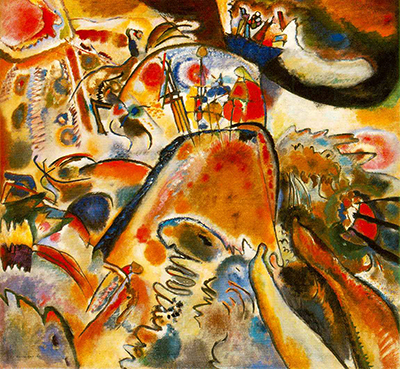Small Pleasures, or Kleine Freuden, to use its original German title, was completed by Wassily Kandinsky in June 1913 and now resides within the permanent collection of the Guggenheim Museum in New York, USA.
This busy, complex piece arrived just a year of so after Kandinsky had completed a flurry of work devoted to the landscape genre. Those were relatively simple in detail and focused most on colour and expression. Here he provides each and every corner of the canvas with visual information and makes use of a red tone as the predominant colour that shows through much of the work. As is his way, it is hard to immediately recognise anything within this painting, and reality feels a long way off from our first couple of glances at this work. It is sized at over one metre tall and wide, allowing enough space for such complexity to be implemented. We also find a strong use of brown tones that work well with the red, as well as blues, yellows, and some black. Kandinsky was never afraid to make use of the absoluteness of black in his work, and appreciated how it provided such power, rather than being concerned about unbalancing his artworks.
There appears to be a good number of figures within this scene, some placed at the very bottom, with others standing upon the various mounds and rolling hills which drift off into the background in a way that belies any accepted use of perspective. Perhaps we are looking at a dreamlike world, but items from reality have been repurposed in such a way that we can only make out just enough to understand the structure of the piece. One would also have to refer to some of the artist's other paintings from 1913 in order to better describe what we are looking at, as well as perhaps some study drawings that may have been produced in preparation for this work. He would often do so for the more elaborate pieces, and Small Pleasures certainly fits into that category, though not all of his drawings have managed to survive to the present day, meaning it be even be necessary to research some of the older publications about his work.
The Guggenheim holds this amongst a number of other Kandinsky paintings. It is rare for any American institution to own so much from this artist's career, as the vast majority remains in Europe. It fits the collection well too, as the focus is on late 19th century art up to the mid 20th century. You will find some of those who inspired Kandinsky featured here, as well as others that he collaborated with on an equal footing. Besides the paintings, which make up the majority of the collection, there are also a number of significant sculptures to be found here as well. In terms of highlights, you would do well to check out the likes of Red Balloon by Paul Klee, The Yellow Cow by Franz Marc and a number of paintings by Amedeo Modigliani.




